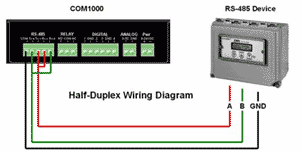 |
 |
|
https://pcmicro.com/COM1000 |

SimpleComTools, LLC
COM1000
User Manual
SimpleComTools, LLC
RS485 Configuration and Wiring The COM1000 RS485 port is an unaddressed transparent interface designed to support any RS-485 equipment. It supports both Full and Half-Duplex communications, so it can be used to interface a single device or a multi-drop network of devices. Applications The COM1000 RS485-port can be configured to perform a number of applications, including acting as a UDP or TCP device server or client, data redirecting via SMTP or FTP, and data arrival event logging. The choice of applications is detailed in the COM1000 Configuration Utility section under the RS485 tab. TCP/UDP Servers The most common use for the RS485 port is as a TCP or UDP device server. In this application, the COM1000 provides the ability to reach RS485 connected devices or device networks from any remote IP host via a standard RAW TCP or UDP socket. Since the COM1000 is a transparent IP to serial bridge, there are no limitations on the data protocol. Any ASCII or Binary protocol will be passed seamlessly to the end device. Communication Drivers The COM1000 IP-to-serial application is a raw socket connection. Therefore there are no driver requirements to establish your connection. As long as your host-end application has the ability to encapsulate the ASCII or Binary data stream into a TCP or UDP packet, you will be able to make the connection. If you host end application does not have that ability, you may need to employ the use of a serial to IP COM Port Redirector. The purpose of the redirector is to make the virtual COM port exhibit behavior that closely resembles that of a "real" COM port, i.e., a COM port driver for local serial port hardware. A virtual COM port itself is a relatively simple software mechanism that can be implemented by driver software similar to that of a conventional COM port driver. The redirector will typically permit creation of many (at least 256) virtual COM ports, and provide the ability to assign or bind a remote IP address of a device server to that virtual port. This, in order to reach a remote device, the host application simply opens the virtual com port associated with that remote device and the connection is automatically established. There are a number of such applications on the market, available from companies such as NetSerial from PC Micro (www.pcmicro.com), TCP-COM from PC Micro (www.pcmicro.com) and VSP from HW Group (www.hwgroup.cz). We also offer a similar application called Virtual-COM UDP that provide Virtual Com Port to UDP redirection only. Port Configuration The COM1000 is capable of supporting a variety of baud rate options, ranging from 1200 – 115200kbps. In addition, the 485 interface supports both full-duplex and half- duplex installations. By default, the COM1000 is setup in Half-duplex mode. In order to support full-duplex, the RS485 Mode register needs to be set (RS485Mode=1). See the RS485 command list for more details on configuring the 485 port options. Wiring The COM1000 RS485 interface has 5 terminals: COMMON (GND), TX+/TX- and RX+ and RX-. When used in full-duplex mode, wiring should follow the specifications set forth by the equipment vendor. The RS485mode selection needs to be set to (1). When used in half- duplex mode, the COM1000 will need to have the TX+/RX+ and TX-/RX- terminals jumpered as shown to the right.
